Don't wanna be here? Send us removal request.
Text

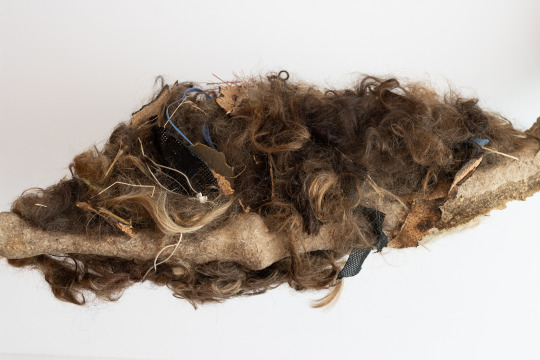
home #1
(recycled pieces of garbage, bones, paper mache, dried flowers, human hair, animal fur)
as part of biennale Manifesta 15 Barcelona Metropolitana
curator: Filipa Oliveira
photos: Ivan Erofeev
2024
~
In her practice, the Lithuanian artist Ruta Putramentaite merges waste and nature to explore what it means to be human in a collapsing ecosystem. Focusing on the asymmetrical relationship between nature and humanity, Putramentaite’s body of work can be read as a metaphor for the status of the environment, a reflection on the impossibility of recycling the tons of industrial materials drifting in the ocean and a critique of the long life and slow decomposition of industrial trash. Through her work, Ruta proposes a new materialism that harnesses humankind’s refuse, bones and other organic materials into new structures that are variably inhabitable. This nest is a metaphor for Casa Gomis and its custodians’ need to protect the residence from succumbing to the threats of airport expansion and sea level rise.
~
Filipa Oliveira
____________________________________________________________
0 notes
Text
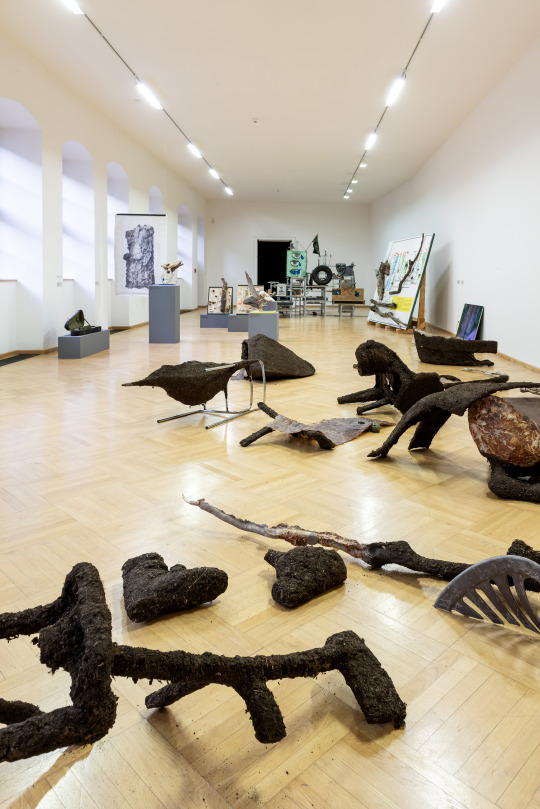

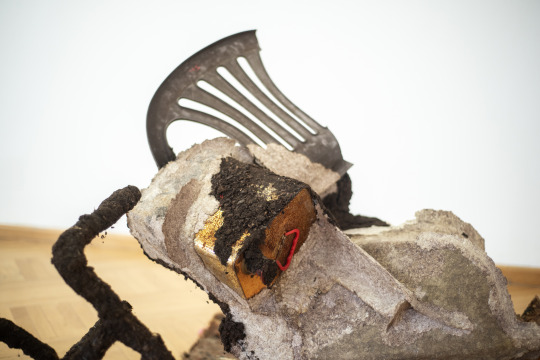
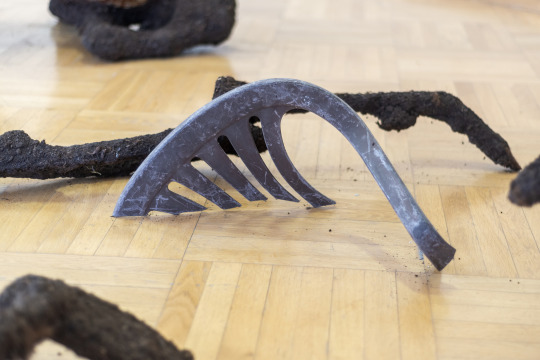
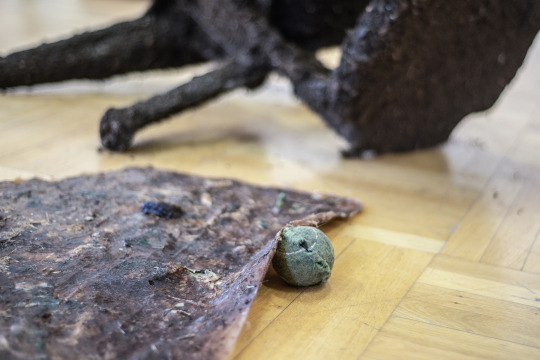
landscape #9
(recycled pieces of garbage, soil, starch, bones, paper mache, kombucha leather, bio-plastic,iron-coloured paper, dried flowers, human hair)
part of the group show Emergency. Preparations for the Future
House of Lords of Kunštát, Brno, cz
curator: Lenka Dolanová
photos: Barbora Trnková
2024
~
The exhibition presents works of art from Central and Eastern Europe that illustrate the shift in perspective necessary in today’s endangered world. The participating artists explore the idea of preparing for the future by cultivating the requisite skills and resilience and also try to find ways of coping with feelings of anxiety.
Art can draw strength from narratives that differ from stories of progress and technocratic solutions implemented by people subjugating nature. It can act as a platform for sharing not only fears but also hope in the possibility of collective problem-solving.
Many people who expect the imminent onset of natural or other disasters engage in practical preparations for such disasters and join prepper or survivalist groups. On the one hand, such people extol the ability to survive in the wilderness, strive to be self-sufficient, and promote DIY solutions. On the other hand, however, they often take an individualistic approach and tend to have given up on the possibility of collective action to prevent future problems. Can one be a prepper and still remain sensitive to the needs of other human and non-human beings that are concerned with more than just their own survival? Is it possible to prepare for future catastrophes and to adopt the positive aspects of survivalism (learning the skills necessary to overcome various obstacles, building support networks, psychological resilience) while still searching for ways of averting disaster?
Many artists respond to the contemporary threats of climate change and escalating global conflict by creating works in which they apply specific forms of perception and sensitivity. The stories they tell acknowledge and name today’s state of emergency while trying to find connections that transcend us and teach us to see ourselves through the eyes of others.
The works in this exhibition explore fears of the impact of military conflict (A[Sv1] nca Benera and Arnold Estefán’s video featuring an audio performance on the Black Sea coast), imagine life after environmental catastrophe (Tamás Kaszás), connect us to the historical layers of nature’s memory with the help of found subfossil trees (Michal Machciník), use ritual experience to encourage us to change our approach to water resources (Martyna Poznańska), help us to process feelings of fear and grief (Pavla Sceranková), or try to see human civilization from a future perspective (Ruta Putramentaite).
~
Lenka Dolanová
______________________________________________________________
0 notes
Text







landscape #14
(recycled pieces of garbage, soil, starch, bones, paper mache, kombucha leather, bio-plastic, iron-coloured paper, human hair, animal fur)
as part of Beneath the Syzygy of Blisters, a duo show with Adam Kozický, Holešovická šachta, Prague, cz
curators: Noemi Purkrábková & Andrew Wilson
photos: Bianka Chladek
2024
~
What body suffers “under the suppurating syzygy of blisters?” Aimé Césaire – poet, militant, and architect of the Negritude (“blackness”) movement – poses this question when faced with the subjugation of his Martinican homeland, an island “sprawled-flat” and pinned by the “geometric weight” of the distant French government and its colonial cartography. In his poetry, Césaire laments the trauma inflicted by the instruments of division and enclosure, the lines on a map which “measure” and “include [him] between latitude and longitude,” reducing his world to a “little ellipsoidal nothing.” Yet Césaire takes hold of the body of his homeland, tracing its lacerations and registering its pain, like an anti-cartographer crafting a “world map made for my own use, not tinted with the arbitrary colors of scholars, but with the geometry of my spilled blood… measured by the compass of suffering.” In his stanzas, a new, militant body is born, as these wounds come into alignment with those of others. Like a syzygy (the alignment of celestial bodies), the blisters on the hands of 20th century Martinican laborers join with the blisters on the feet of a refugee crossing the Polish-Belarusian border today, offering one rueful glimmer of hope living in “the age of the refugee, the displaced person” (in Edward Said’s words): while there may be a million blistered victims of the border, they share a common struggle…
This poetics of the border and its transgression inform the joint exhibition of Warsaw-based painter Adam Kozicki and Prague-based sculptor Ruta Putramentaite, which interrogates the boundary line transversally: at one scale, it figures as a social and geopolitical frontier to be crossed, opposed, or evaded, and on another scale, it announces the planetary transgression of borders between bodies, objects, and relations. As Earth warms and its raw materials enter into frenzied circulation, we are struck by the rate at which the “social” and the “human” dissolve alongside other organic and inorganic forms. Yet at the same time, we are struck by the way in which such mobility is matched by even more rigorous immobilities, how just as interior frontiers disintegrate in viroid, transmutative exchange, exterior frontiers are ever more rigorously expanded, enforced, and weaponized. It’s blisters all the way down.
Linking these two scales is the image of a swamp. Out from the friction of soil on chrome on plastic on flesh, heated and pressurized under the bubbling veneer of marshlands, swells a form shed of all instrumentality, value, recognizability. Putramentaite’s shapes speculate not only on a present shaded by extinction and collapse, but an ambiguous future in which there is no “wealth” nor an “immense collection of commodities” to actualize it: no borders between classes, hierarchies, species, geographies, materialities. Yet there is no assurance of utopia here, just a nagging suspicion that “we” may not be witness to this future at all. What we do witness in the present, depicted in Kozicki’s landscapes and figurations, is thus made all the more urgent: the stale, surveilled interior of a police detention center, a harsh, entrapping spotlight probing through the marsh, images of claustrophobia, paranoia, mobile immobility. Here the swamp reveals its contradictory nature: we encounter a zone of stasis and inertia teeming with perverse vitality, a possibility of shelter and certain danger, an inoperable terrain serving as a limit yet perforating the border winding through it. The swamp is an emblem of the types of zones that borders create: a logic of “expansion by expulsion” (as philosopher Thomas Nail writes) pulls refugees and migrants into a pattern of motion that holds them in states of suspension, pulling them in to extract labor, fines, or information only to cast them back out, tempting them to return only to track them deep into the territory and enclose them from within. Yet the swamp itself is also an emblem of James C. Scott’s “non-state spaces,” socio-geographical constructions that thwart the full control of the nation-state and act as a fortress against capture, coercion, capital. Sitting in this swamp, enmeshed in crawling vines, we are thus left with a singular view: billowing yellow skies peaking through darkening treetops, a political horizon barely perceptible through the underbrush, yet there if we will see it…
What we see is that every form is unstable: human tissue, chicken bones, a plastic bottle, barbed wire. But this shared pull of entropy does not mean we should consider the human or social with any less urgency: rather, as we begin to perceive these forms in all their fragility and contingency, we can rid ourselves of the “eternal” truths, “traditional” values, and “historical” teleologies that serve so well to enforce xenophobic, racist, sexist, or otherwise oppressive divisions. What we see is what Césaire saw – lines on a map as mutable as the bones in a bog. Blisters and wounds like a new cartography, navigating us through the swamp, where all the “geometric weight” of the present state caves in on itself…
~
Noemi Purkrábková & Andrew Wilson
___________________________________________________________
0 notes
Text

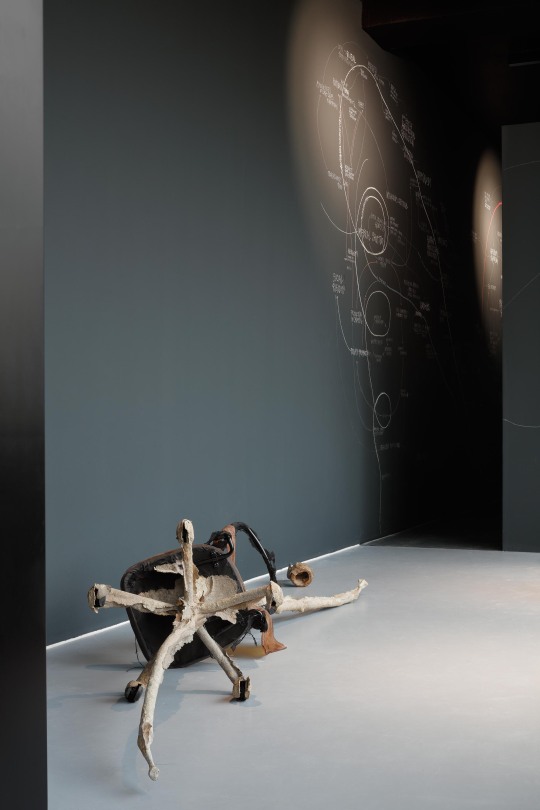
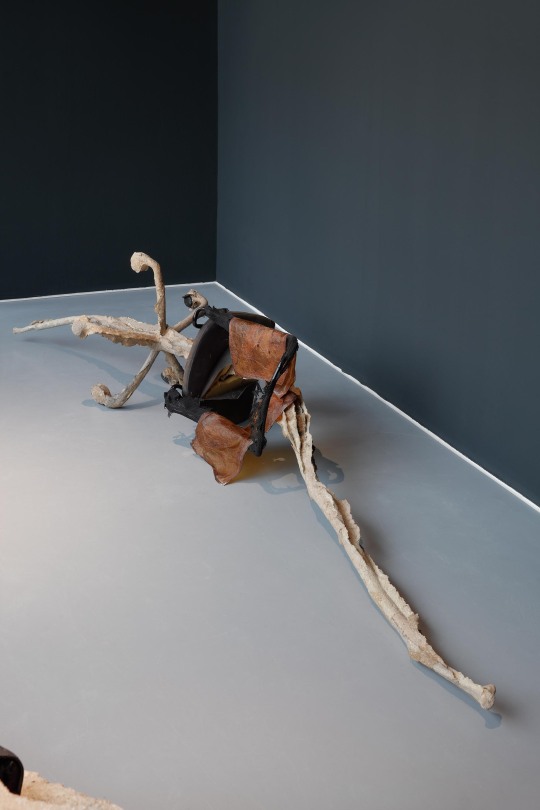

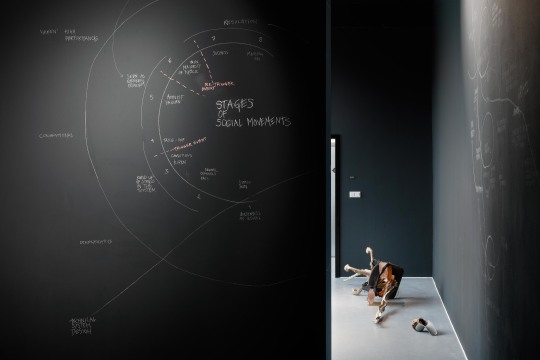
landscape #6
part of a group show (R)uins & (R)evolution, House of Arts Ustí nad Labem, cz
curator: Mariana Serranová
2023
––––––––––––––––––––––––––––––––––––––––––––––––––––
0 notes
Text
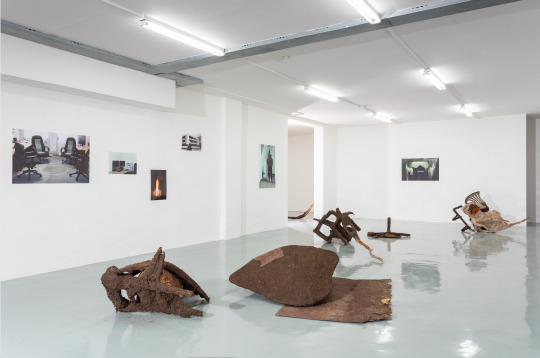
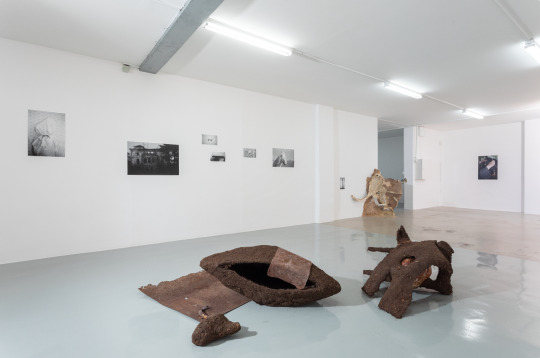
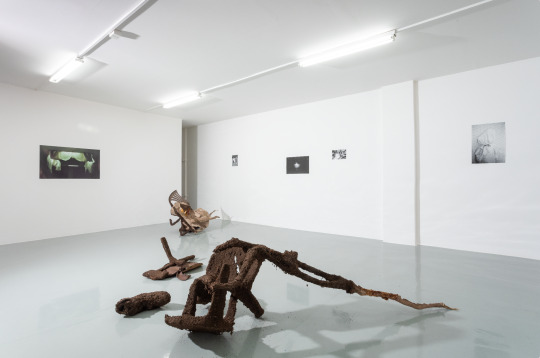
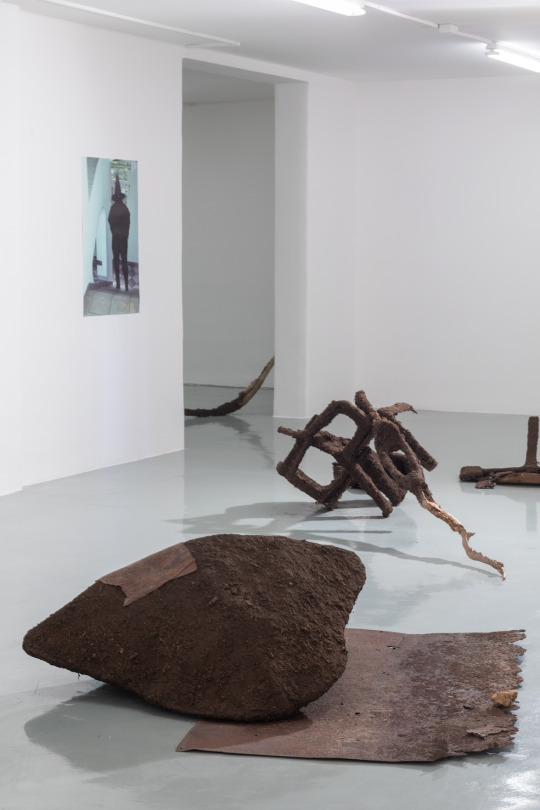
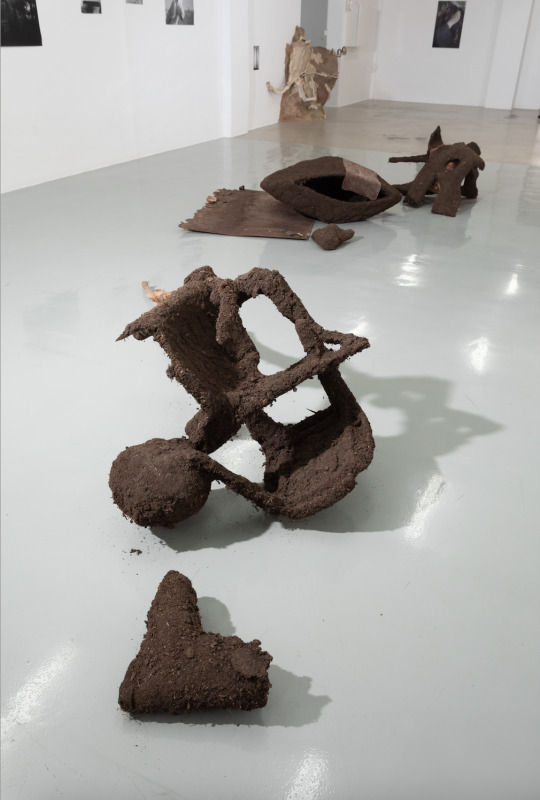
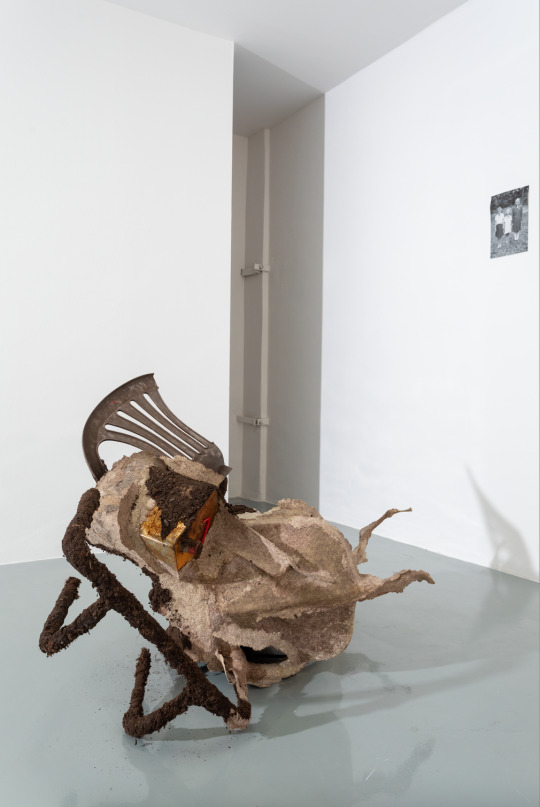
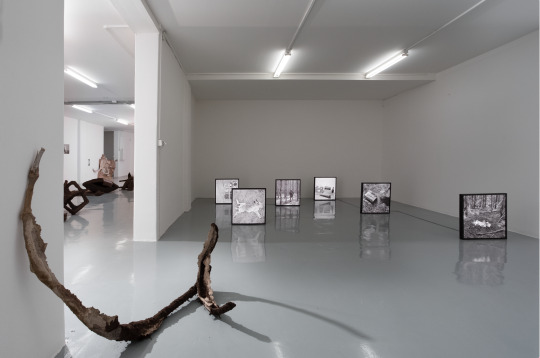
landscape #3
(recycled pieces of garbage, soil, starch, bones, paper mache, kombucha leather, iron-coloured paper, human hair, animal fur)
as part of a duo show What's Inside the World, Always Present, and Matter, That Dreams of Awakening,
together with Tereza Jobova at kabinet t gallery, Zlín, CZ
curator: Iva Mladičová
photos: Libor Stavjanik
2024
~
We walk through a probable landscape of the far future, where the transformation of objects into organisms makes it impossible to distinguish the organic from the inorganic, and through photographic cycles in which utilitarian things become magical objects, we look into the landscape of the interior. Both spaces are at first sight deeply disturbing, as they testify to the presence of invisible undercurrents. The two artists use different means of expression in the current exhibition, but they have a powerful synergy in the exhibition as a whole.
<...> Ruta Putramentaite creates installations and environments from specific object-organisms, hybrid material and object combinations. So far perceived as contrasting, she attempts to re-establish them in symbiosis. She collects industrially produced waste and hand-models the shapes of the found objects, exploring the materiality of the existing and creating new materials (kombucha, bioplastic, papier-mâché). She contemplates the distant future. Despite the divergent intentions of pragmatic human action and the existence of natural organisms, she perceives the possibility of a meaningful "digestion" of existing civilizational production by the biosphere.
<...>
"The basic reality is a creative wilderness in which everything interpenetrates each other, transforms itself, pushes itself towards life and brings death with it. This wilderness is neither spatial-material nor spiritual-abstract, but one and the other: materiality and non-material meaning, life and decay, coherence and incompatibility", Andreas Weber characterizes his vision of the complexity of existence in Matter and Desire. The title of the exhibition is taken from this book, as it contains many areas of contact with the artists' thinking. Andreas Weber views the whole of nature, full of highly complex, non-linear connections and far-reaching flexibility, through the prism of the principle of subjectivity.
The presence of the surreal, the reciprocity of the disparate, the consciousness of the latent, the sensitivity to the sustainability of life in general, aspects of materiality, the existence of objects and their transformative potential are themes in which the authors meet in a stimulating way. Through their works they remind us of the existential attachment of man to symbolic natural processes and encourage us to reflect on the possibility of a way out. This can be a conscious transformation of attitude, since everything that serves life can be understood as a gift.
Iva Mladičová
––––––––––––––––––––––––––––––––––––––––––––––––––
0 notes
Text
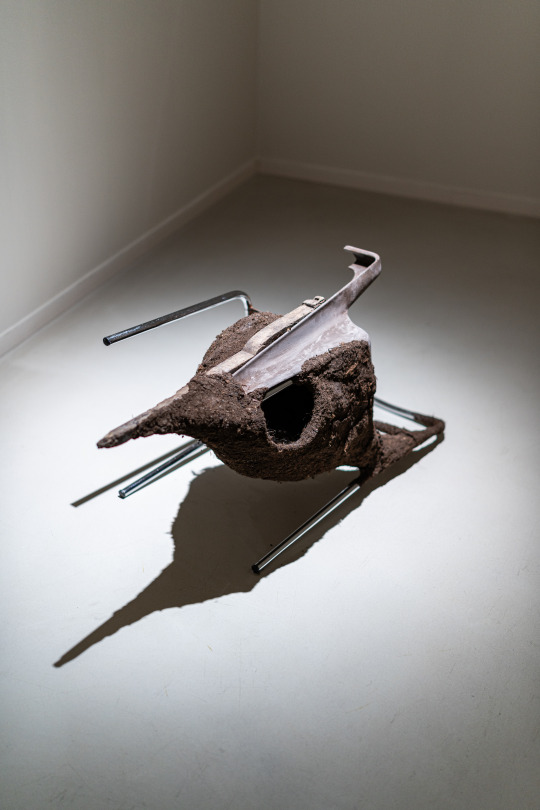


home #7
an earthy cocoon living on the recycled parts of several chairs
as part of Escaping the Post-Soviet in Liberec galery, Liberec, CZ
2024
––––––––––––––––––––––––––––––––––––––––––––––––––
0 notes
Text
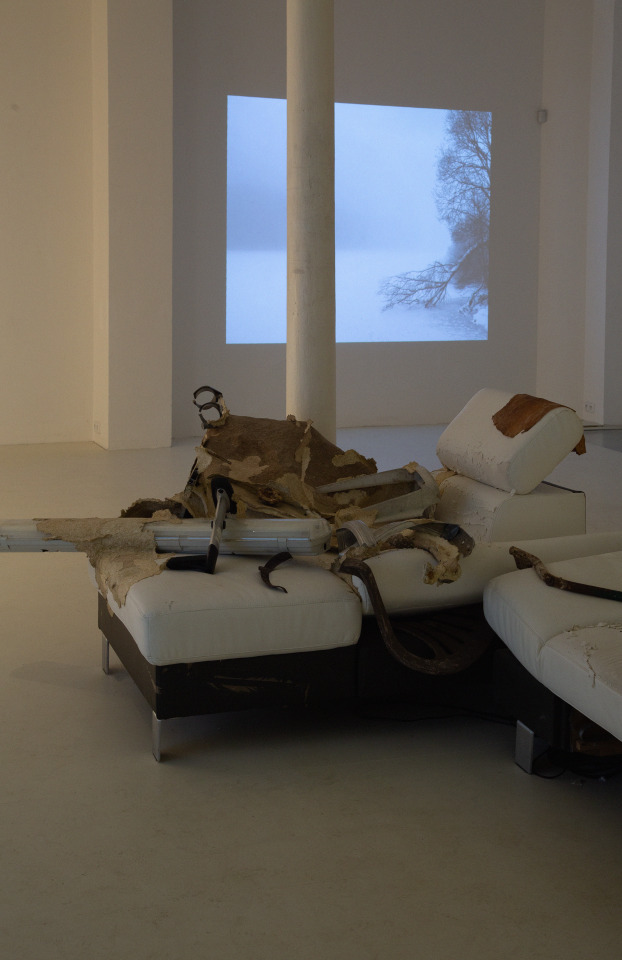

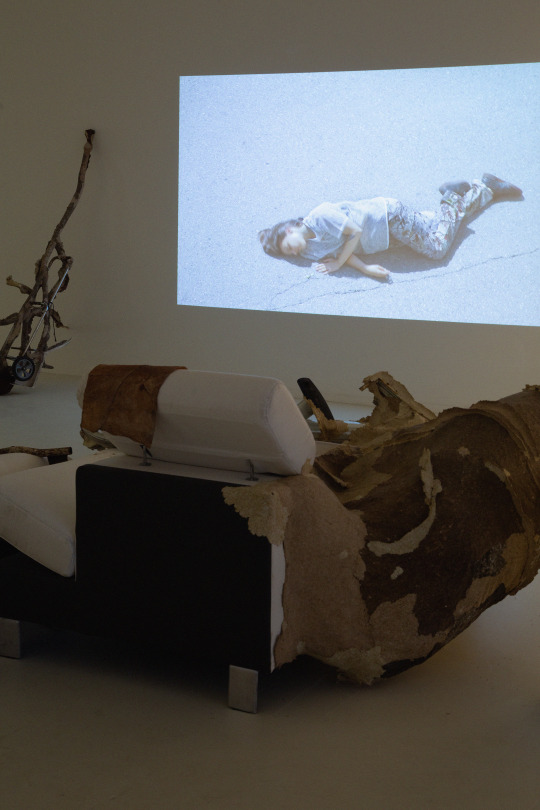


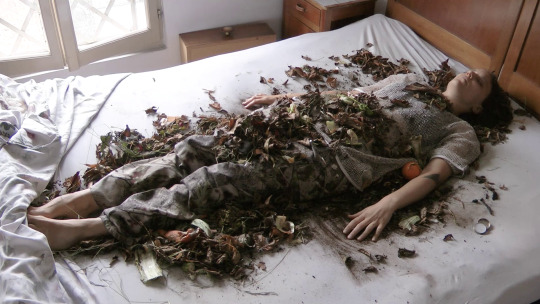
video & creature-objects made together with Denisa Langrová
(video, discarded objects, paper mache, chicken and cow bones, kombucha leather, soil, sugar syrup, cinamon, tea leaves, bio-plastic, iron-dyed paper, animal fur)
part of a group show Sometimes in Winter at Cursor gallery, Prague
full video And Now I gather Soil and Bones can be seen here
curator: Marianna Seranova
2023 / 24
~
Sometimes in winter
At the waning of the century, with the weather warming, and even seasons losing their way. Linda Pastan, December 18: For M (Poetry, December 1990)
“Winter temperatures overall are still expected to be above average, with varying degrees of deviation from the norm. Some models indicate temperatures will be well above average, others only slightly. This is based on the assumption that winds will tend to be west to south-westerly. Periods of cold air cannot be ruled out, one of which we are experiencing even before the onset of winter.” (Outlook for winter 2023/2024, Meteoaktuality, 5 December 2023)
Out of the blue comes a storm. A storm means a flooded basement. After a dry year, expect another dry year. Little rain, an empty barn. The deeper the well, the less water. Mud before Christmas, mud after Christmas. Radek Štěpánek, From The New Weather Lores (2023)
<...>
New winter backdrop
Our life is like ski tracks in the white expanse: swept away by the snowstorm at early dawn. Paulus Utsi, Giela Gielain (1980)
the sharp tips of spruces it’s not snow just bare wood at a height at which the wind has swept like a giant spinning snowflake was last year a waste of time?
the skier was almost hit by a falling drone
(…)
We don’t remember how many seasons this winter has to last?
Oh, ages I’m sorry?
Ages
When we want summer, we travel just like spring and there are people who want just for a while to exchange winter
for autumn’s departure and forgiving to prepare again, this time more carefully Katarína Kucbelová, k bielej (2022)
Winter kept us warm, covering Earth in forgetful snow, feeding A little life with dried tubers.
(…)
I read, much of the night, and go south in the winter. T. S. Eliot, The Waste Land (1922)
Mariana Serranová
______________________________________________________
0 notes
Text
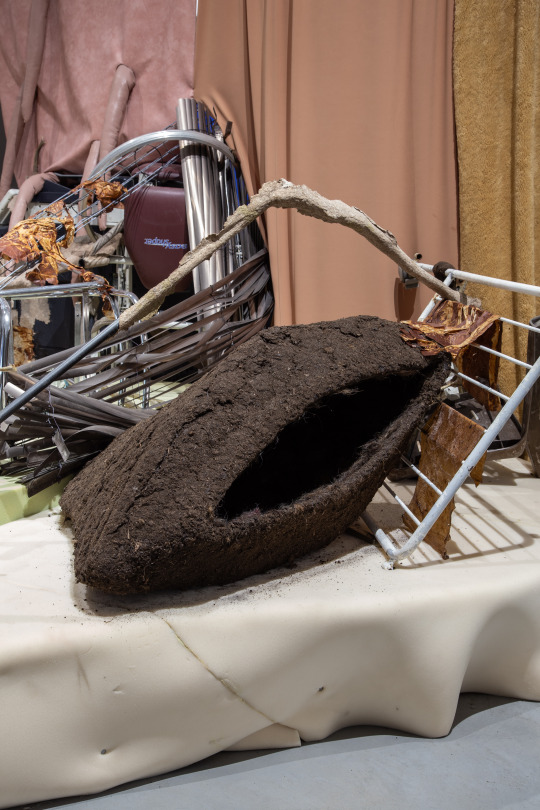
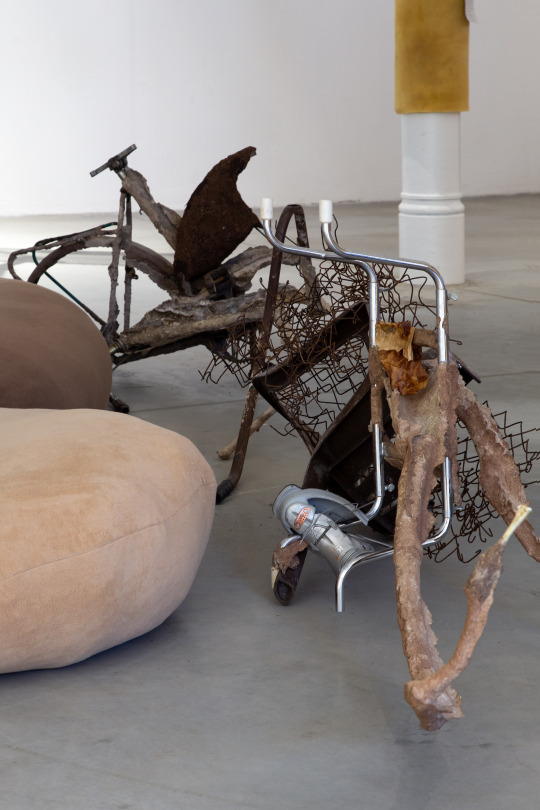
creature #18
(discarded objects, paper mache, chicken and cow bones, kombucha leather, soil, sugar syrup, cinamon, tea leaves, bio-plastic, iron-dyed paper)
as part of Escaped, Found a Hideout, Still on the Run exhibition at gallery Plato, Ostrava
curators: Eva Koťátková, Jakub Adamec, Edith Jeřábková, Zuzana Šrámková
2023-2024
_________________________________________________
1 note
·
View note
Text



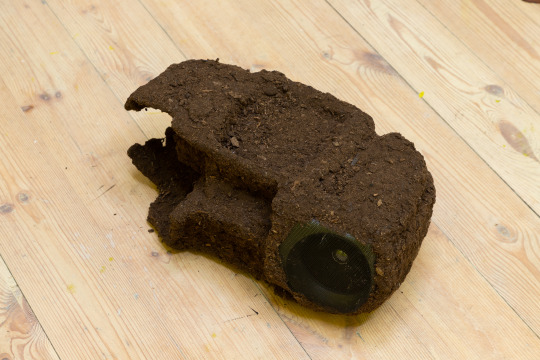
landscape #4
(discarded objects, soil, sugar syrup, paper mache, kombucha leather, wood branches, chicken bones)
as part of a Blues Explosions exhibition at Gallery 35m2, Prague
curator: Tea Záchová
foto: Peter Kolárčik
2023
~
The latest exhibition, Bleus Explosions, closes the chapter of Nuclear Culture at 35M2 Gallery. The last section explores the theme of nuclear waste and concludes with the theme of a toxic future not only in terms of the impact of radiation. The title is inspired by the French artist Yves Klein and his 1958 letter to the president of the International Atomic Explosions Confederation. In it, he responds to the testing of atomic bombs not only over Nevada, and in it he himself suggests to the Confederation to blue with its famous ultramarine blue called IKB the places where the testing took place. The artist's main point was to create a kind of map to show where the atomic bombs landed, so that their location would be recorded - it was also a political act to show that there were not exactly a few of them.
<...>
The exhibition reflects not only on the politics of waste in the context of toxic manipulation and what we are leaving for future generations, but also on the problematic nature of contemporary climate change, to which these phenomena are risibly linked. How long can such a place serve without being dangerous? Is it ethical to submerge waste in underground disposal sites? What we do know, however, is that we are occupying sites, either after atomic and thermonuclear explosions, which have to be reclaimed over the long term from toxin and radiation deposits, even after several years, or sites that have yet to meet this fate as deep-sea repositories. The group exhibition thus shows different critical perspectives on working with waste, recycling or the memory of a site affected by the experience of an explosion.
<...>
Tea Záchová
____________________________________________________________
0 notes
Photo
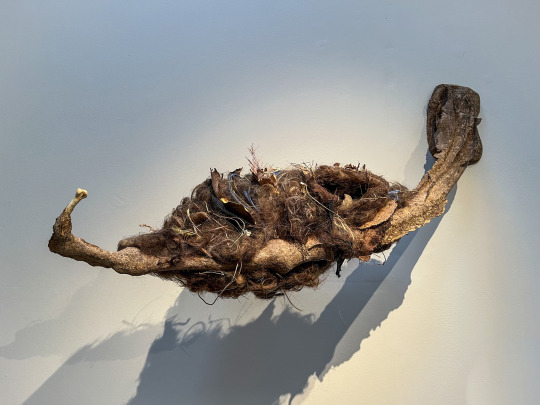
home #1
(pieces of garbage, human hair, paper mache, chicken bones, dreid flowers,a tree branch)
as part of The Earth group show, Atrium Žižkov, Prague, cz
curator: Ondřej Horák (Fuczik)
2023
~
The materials that surround us mostly come from natural sources. Nature is still around us, we just don't see it anymore. We don't perceive it. We take, but we don't know from whom.The trachyte slabs that make up the gallery floor are up to 13 million years old. The gravel that we use to fill the roads in winter or the sand in the children's sandbox is even older. The oldest tree in our country is two thousand years old, but even the common trees that make up the wooden shelves in Ikea have been around for at least 150 years. Drinking water sold in PET bottles comes from underground springs that are tens of thousands of years old. A single person uses up to 100 litres of water a day. A hen can lay 300 eggs a year. A typical meat processing plant can process up to 250,000 chickens every day. Stone, water, wood, air, animals. Blocks on the pavement, bottled water, a kitchen chair, an egg for breakfast.The exhibition consists of a combination of natural materials, products created from natural resources and works by contemporary artists.
<...>
Ondřej Horák (Fuczik)
__________________________________________________________________
0 notes
Photo










here all is distance there it was breath
(garbage, paper mache, kombucha leather, soil, sugar, bioplastic, flax seeds, wood, bones)
solo show at Foundation and Center for Contemporary Arts Prague, cz
curator: Mariana Serranová
2022
~
"I wish I could dig all the way to the bottom. Perhaps I´d understand the past-world, and the people that threw this all away."
Emmi Elina Itäranta, Memory of Water
For several years, Ruta Putramentaite’s sensitivity has been focused on the asymmetrical relationship between man and nature. Her works are a fragmented metaphor of the environment, reporting on the indigestibility of human activity. She puts into context different conceptions of the passage of time, of life and of the decomposition of organic and inorganic matter. In one breath we perceive the endless biochemical reaction of the universe of which we are a part as a profound existential experience. But, paradoxically, with the knowledge that our human age will never have enough time to fully comprehend it.
By recycling discarded, dysfunctional vehicles, that were part of human reproduction and movement on the earth's surface, into exhibition artifacts, Ruta communicates with the ethical premises of the new materialism. The long life of industrial products, their slow decomposition and their subsequent journey into the earth - with all this, the artist gives nature and geological time a far more optimistic perspective than we as humans can attribute to ourselves. We now know that the garbage patch in the Pacific Ocean has exceeded the size of Texas and is approaching the size of all of North America. The time for recycling the tons of industrial materials drenched by seawater has expired, many materials are mechanically breaking down into tiny particles. Likewise, human movement, activity, and production are tied to mineral resources, its gravity, and the nutrient processes that include water, which is involved in the chemical process of decomposing organic and inorganic matter.
The only thing that remains from an unburned body are the bones. It is one of the hardest tissues in the human body, and ions of calcium, phosphate and other minerals can be released and stored there as needed. Just as stones are subject to weathering by the action of water and carbon dioxide, bacteria, algae, lichens, mosses and higher plants enter the process of rocks and minerals, whose death produces a thin layer of organic matter as the basis of soil fertility. The scientific description of natural cycles and evolution allows us to see our existence as a kind of external experience. We gain insight into the continuity of the material world, whose laws transcend us.
The ecological engagement within us largely takes place in irrational territory. In the domain of art, more than anywhere else, problematized phenomena are freed from their original context somewhere in reality to be recalled as symbolic images here and there. Through Ruta Putramentaite's installation we observe the interconnectedness of industrial and natural processes. The artist critically breaks down the separateness of these and other categories. Instead, she focuses on their physical basis and their mutual ingestion. In elaborating the connections and relationships between discarded industrial debris, natural materials and soil, we observe how the tooth of time and the general degradation of materials returns human activity to the earth once again. We feel that the key to understanding the physical world is an awareness of our corporeality and mortality.
Mariana Serranová
––––––––––––––––––––––––––––––––––––––––––––––––––––––––––––––––
0 notes
Photo


home #2
(metal construction, paper mache, fabric, audio installation)
part of a group show WOM*N-ROSE-SONG-BONE at Display, Prague, cz
curator: Hana Janečková
2021
“The large scale papier mache objects of Ruta Putramentaite, closely resembling geological forms, insects’ nests, horns and bones, play with formal, sculptural properties such as weight and scale, worked through their ambivalent materiality. Attached to the institutional walls, they interrogate its structure, resembling casts from man made building materials interlayered with strips of meat and bone, their cavities recalling interiority of the body.”
Hana Janečková
____________________________________________________________
0 notes